Cycle News Staff | March 21, 2018
Honda CRF250L vs. Kawasaki KLX250 vs. Yamaha WR250R | Dueling Dual Sports
We compare the latest entry-level 250cc dual-sport bikes from Japan.
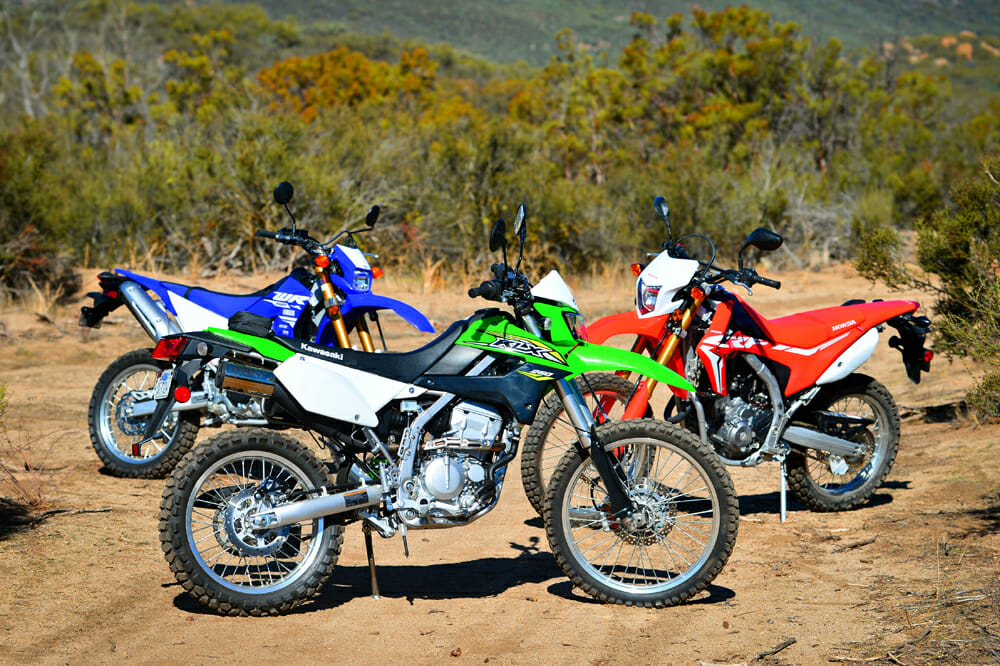
Kawasaki lit a fire under the entry-level, low-cost 250cc dual-sport category when it announced its first fuel-injected KLX250 dual sport late last year, replacing the carbureted KLX250S of the past, a move long overdue when you consider Yamaha has had a similar model—the WR250R—with fuel injection since 2008. It wasn’t until 2013 that Honda responded with its first fuel-injected 250cc dual sport, the CRF250L, and now that Kawasaki has joined the FI ranks with its 2018 KLX250 (the S designation disappeared along with the carburetor), it’s time to revisit these machines once again.
Cycle News last compared these models in 2013, and since then, the CRF250L has, like the KLX, been updated as well. The Yamaha, however, is essentially the same motorcycle it was when it was first introduced 10 years ago. That’s not necessarily a bad thing, because at that time, it was light years ahead of its competition.

PHOTOGRAPHY BY KIT PALMER
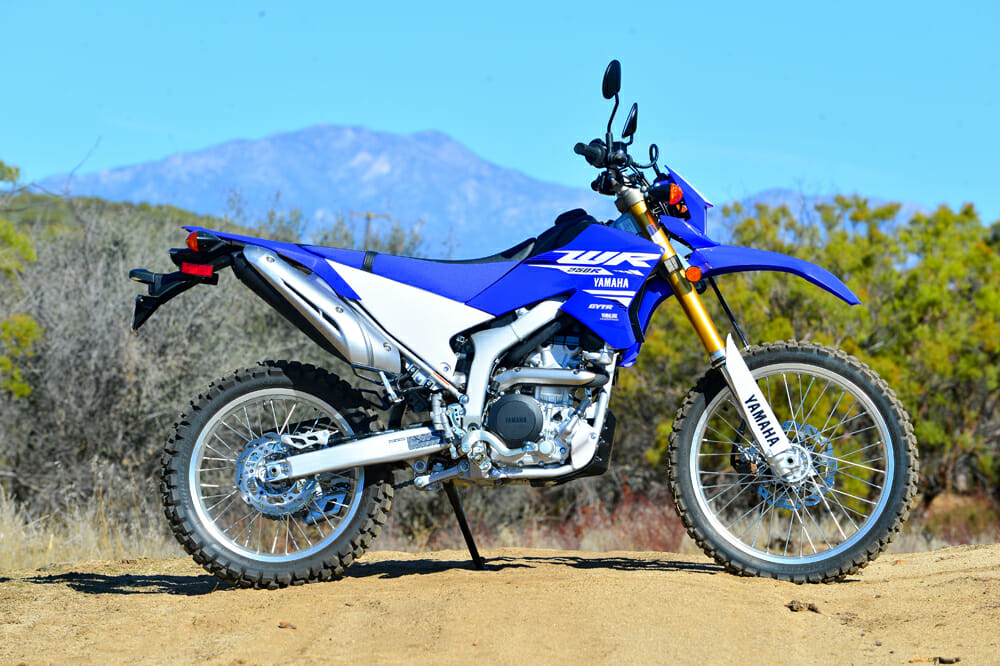
Yamaha WR250R
When the WR250R—a motorcycle inspired by its WR250F off-road-only cousin—made its grand entrance in the U.S. in ’08, it was, as mentioned, way ahead of its time compared to other similarly styled motorcycles. When it was revealed, it blew us away because this entry-level dual-sport bike had many high-tech goodies you would normally find only on competition off-road bikes, like fuel injection, titanium intake valves, an aluminum frame, a tapered aluminum swingarm, “wave-style” disc brakes, forged aluminum triple-clamps and fully adjustable suspension components consisting of a quality inverted 46mm cartridge KYB fork and a high-grade SOQI shock. This bike had a lot going for it. Heck, Yamaha’s YZ-F MX bikes didn’t even have fuel injection at the time.
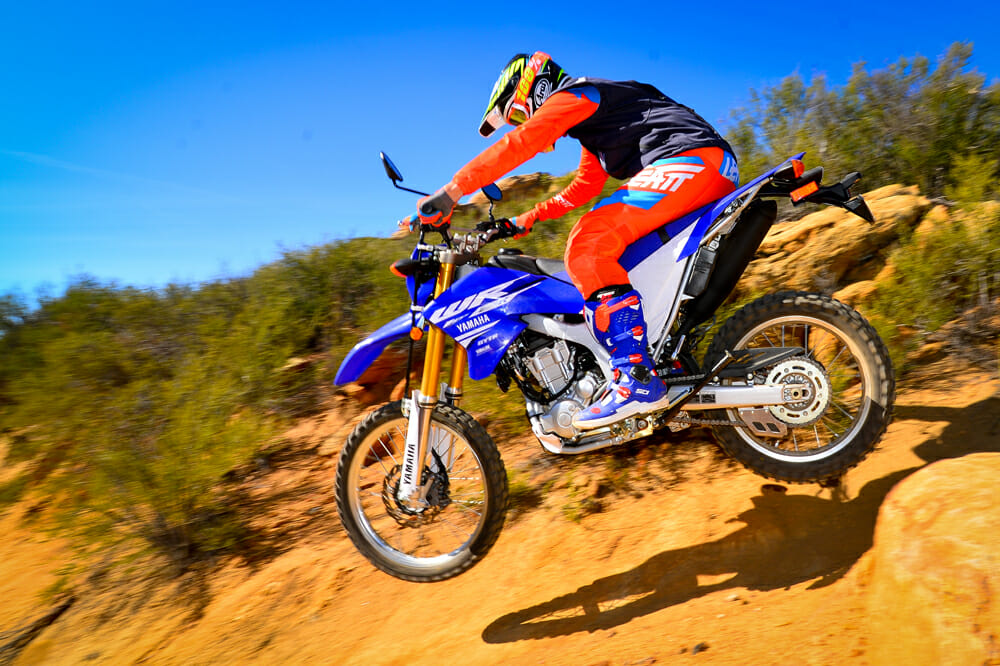
Unfortunately, there was a price to pay for all these things—the price. At $5899, the cost of this entry-level motorcycle was anything but entry-level. In comparison, the KLX250S—the Yamaha’s number-one competitor at the time—sold for about a $1000 less.
The 2018 Yamaha WR250R returns much like it was 10 years ago but with an inflated price tag of $6699.
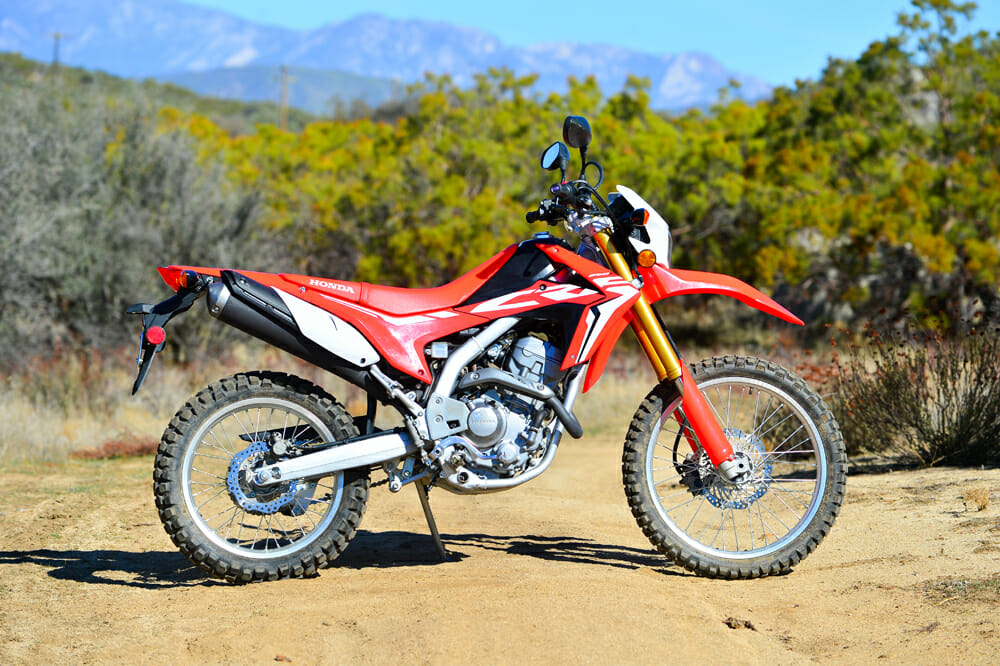
Honda CRF250L
The Honda CRF250L came on the scene in 2013. It caught our interest at the time because it was an all-new motorcycle filling a gaping hole in Honda’s dual-sport line of entry-level dirt bikes, it had fuel injection and was dressed up to look a lot like its CRF-R MX brothers. And it came with an amazingly low MSRP of $4499.
It also had some cool things like a twin-spar steel frame that was painted silver to mimic the CRF-R frames. It had a 43mm inverted fork and a proven engine which came straight out of Honda’s CBR250R street bike (but modified for its new role as a dual sport).
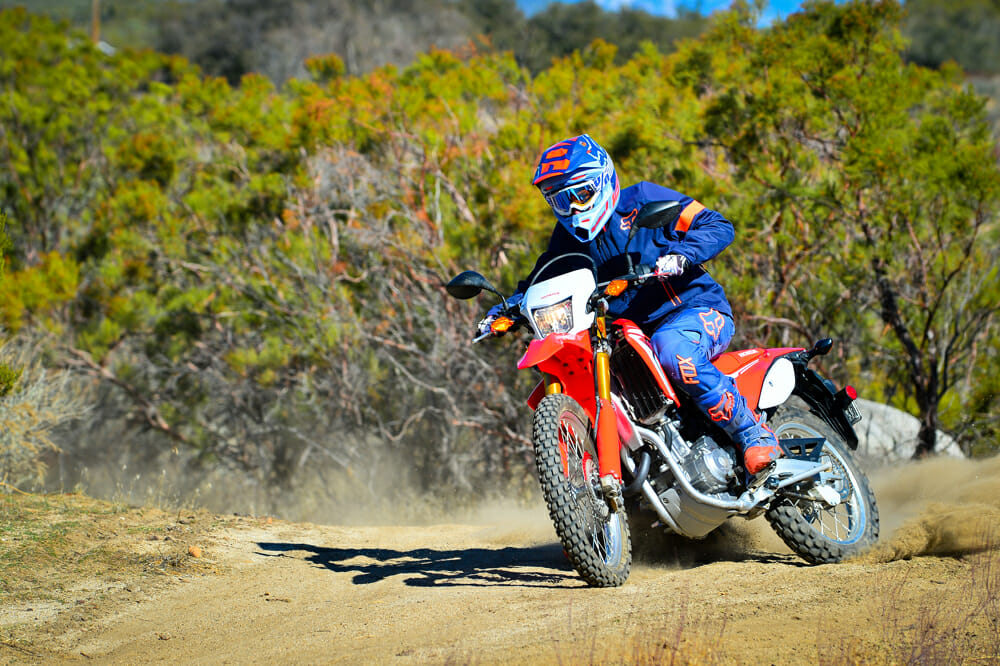
The CRF250L got its first revamp last year. Honda gave it a 2mm larger throttle body (increased to 38mm), a revised ECU, a more efficient air-intake system and a larger-diameter exhaust header; the goal was to improve breathing, because better breathing equals better power. Honda also started offering ABS as an option with the ’17 model.
By shaving 0.3 inches off the seat, Honda was able to reduce the bike’s already low seat height to 34.4 inches. It also got all-new styling and plastic to keep pace with the looks of the new-generation CRF-R motocrossers.
What hasn’t changed? It’s 2.1-gallon fuel tank, 256mm (front) and 220mm (rear) disc brakes, non-adjustable suspension and its digital meter.
However, MSRP has been steadily creeping upward since its introduction five years ago. It’s now $5,149.
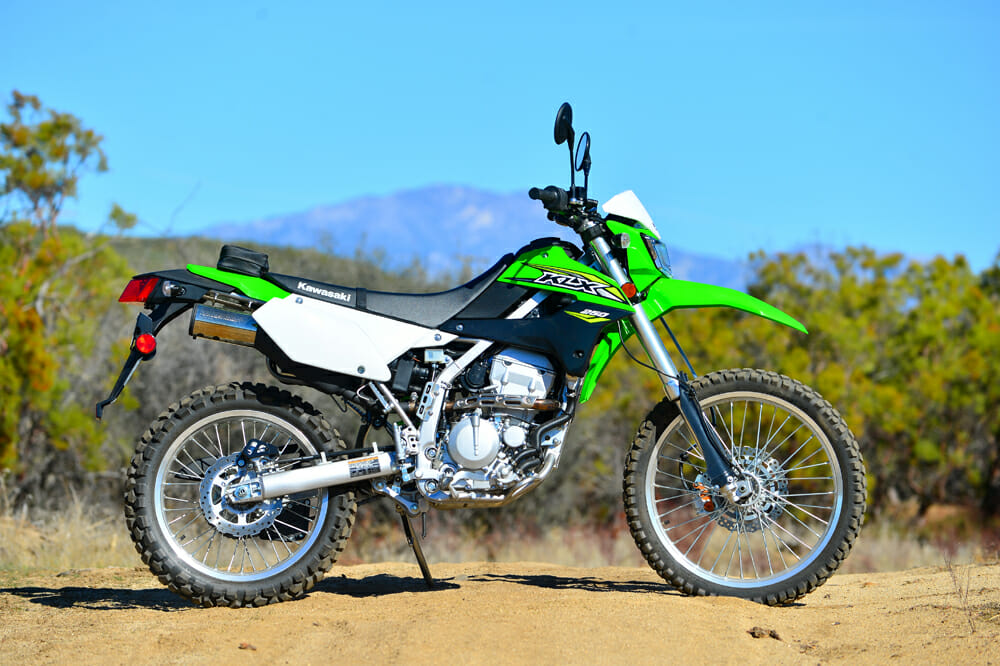
2018 Kawasaki KLX250
The KLX250’s last major overhaul came in 2009. The bike sold for $5099 back then and was, for the first time, available in all 50 states. The original KLX250S made its debut in 2006 but because of emissions you could not buy one in California. However, new carburetion changed all that in ’09—for a while at least.
That year (2009), the KLX took on many other changes, as well. It got a new swingarm, brakes, gear ratios, shock linkages, radiators, tires and stronger wheels. Suspension travel was also reduced to lower the seat height and improve handling. And, it got a major facelift. All good stuff. But what it really needed was FI. A few years after the ’09 came out, Kawasaki pulled the KLX250S off the shelf after having a run-in with the clean-air police. But all is good now thanks to FI.
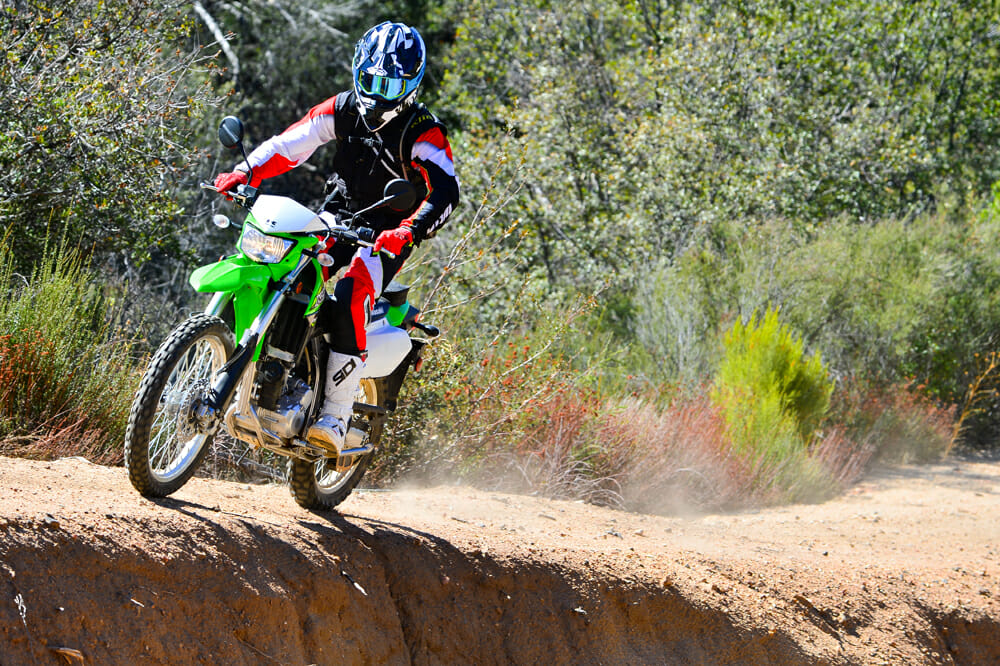
The 2018 KLX250, which sells for $5349, took on a few other minor changes besides FI. Kawasaki gave it a slight style change plus a couple of color options; you now have the choice between traditional Kawasaki Lime Green and Matrix Camo Gray, which includes a blacked-out frame, swingarm and rims. You’ll pay $200 more for the Camo version.
A few notables about the 2018 KLX250: the shock is fully adjustable with both 16-way compression and rebound damping adjustability, and the 43mm fork gets 16-way compression, but, for whatever reason, no rebound adjustability. It also has petal-style disc brakes, generous 11.2 inches of ground clearance, sturdy engine guards, a large and informative meter and a claimed ready-to-ride weight of 298 pounds.
TIME TO RIDE
All three of these bikes are fun, simple and easy to ride, and for these reasons alone, are ideal options for the entry-level rider for both street and dirt bike riding. Of the three, however, the Yamaha takes it one step farther for also being a fully capable off-road motorcycle for the more experienced rider. The number-one reason being suspension. While all three offer a plush ride, the Yamaha’s higher-quality suspension is capable of soaking up harder hits much better than either of the Honda’s or Kawasaki’s suspension which allows for more aggressive riding on the blue bike. It takes lot more to get the Yamaha’s suspension to bottom out compared to the Honda’s or Kawasaki’s. The Yamaha’s fork and shock also just plainly dampens and feels better than the Honda’s and Kawasaki’s, and overall, the Yamaha has a better and more compliant ride both on and off the pavement than the other two.
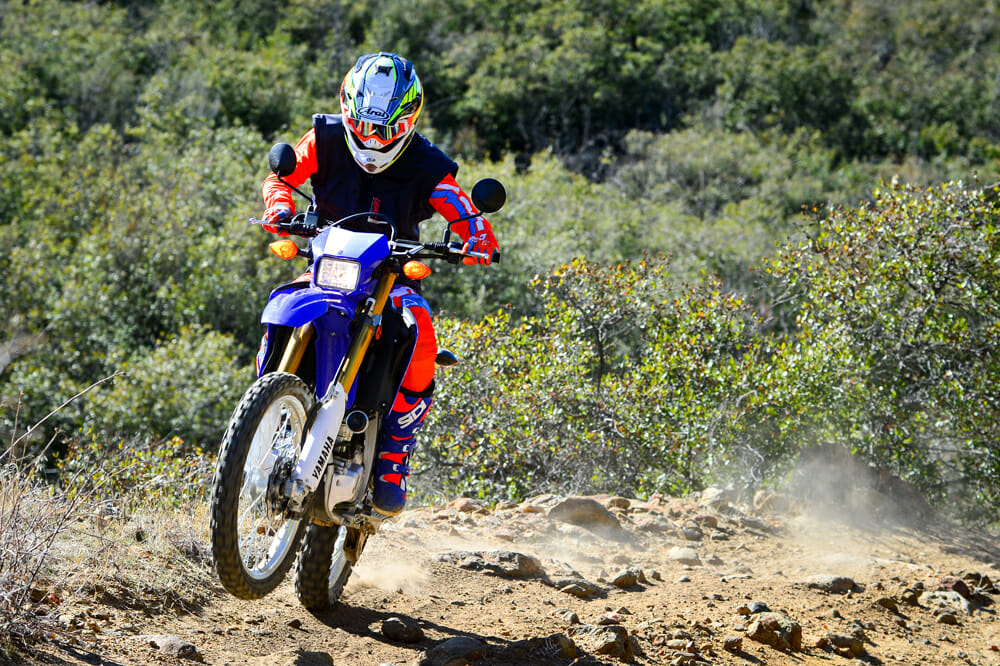
GEAR ID’D
HELMET: Arai VX-PRO4
PANTS: Leatt GPX 4.5
JERSEY: Leatt GPX 4.5 Lite
BOOTS: Sidi 3 SR
Between the Kawasaki and Honda, the Kawasaki’s suspension is most comparable to the Yamaha’s. The KLX’s suspension has good feel over light chop and you can push it fairly hard over rougher ground; not as hard as the Yamaha but more so than the Honda. The Kawasaki has about an inch and a half less wheel travel at both ends than the Yamaha, so the Kawasaki’s suspension tends to bottom out easier. The KLX’s suspension is almost as adjustable as the WR’s.
The Honda lags a bit in the suspension department, but that is only a concern for the more experienced rider who will complain that the CRF’s fork and shock are way too soft and bottom easily; it has the least amount of front-wheel travel of the three bikes and just slightly more rear-wheel travel than the Kawasaki. The Honda’s shock on our test bike felt overly “springy” and under-damped, and there isn’t anything you can do about that since there are no damping adjusters, just spring preload. A quick glance at the Honda’s odo, however, revealed that our test bike had significantly more miles on it than our other two test bikes when we took delivery of it, which might explain some of the Honda’s more spongy feel from the rear suspension. However, a true beginner or first-time rider won’t complain at all but will instead enjoy the Honda’s ultra-cushy ride and low seat height, by far the lowest of the three.
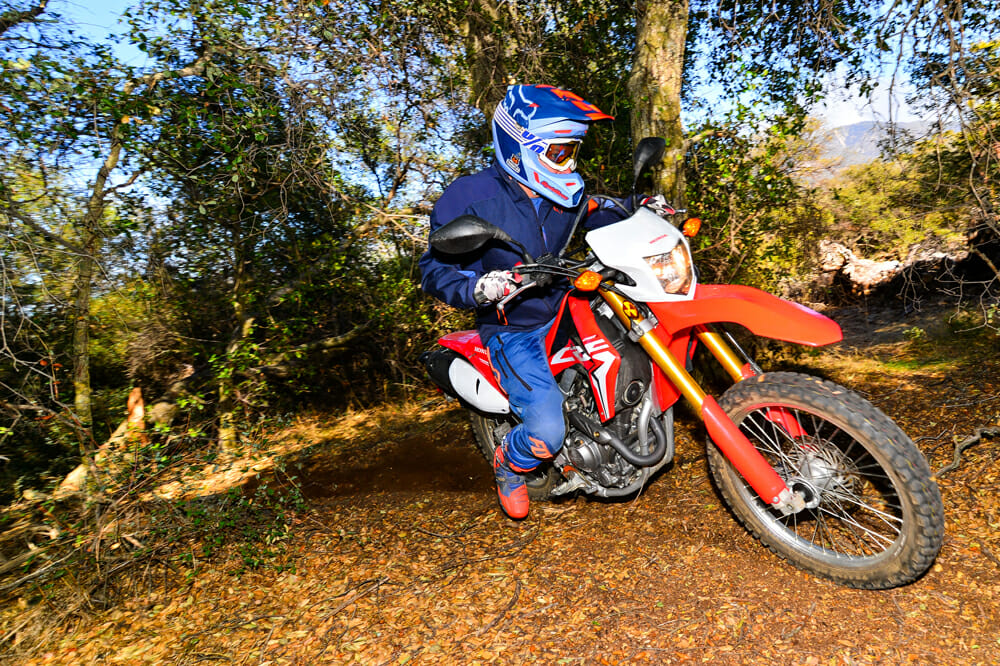
GEAR ID’D
HELMET: Fox V1
GEARSET: Fox Legion Offroad
BOOTS: Fox Instinct Offroad Boots
GOGGLES: 100% Racecraft
In the power department, the Yamaha wins again—as long as having the most means everything to you. None of them, however, are rocket ships, that’s pretty much a given with these bikes, but the Yamaha moves along pretty good for what it is. The Yamaha is noticeably more powerful than both the Kawasaki and Honda, but most of that power is lurking in the higher rpm range, a fun place for an experienced rider but maybe not so much for the true beginner. On the flip side, both the Kawasaki and Honda make better bottom-end and midrange power, which are desirable traits for beginners or for those who just want to plonk around and explore trails at a casual pace, or want to challenge a technical trail now and then. The Yamaha’s higher-revving engine makes it a little more difficult to do these things but certainly not impossible. All three bikes, especially the Yamaha, would be better off with lower final drive gearing for riding on dirt.

Of the three engines, the Honda’s and Kawasaki’s are most comparable. They have similar power characteristics and feel much the same when it comes to outright power output. Whatever the difference between these two is negligible.
Smooth, precise and predictable low rpm throttle response is critical for riders new to motorcycling, and all three bikes have just that—excellent throttle response.
The KLX’s fuel injection is a major improvement over the previous carbureted KLX. Not only is throttle response better now that it is fuel injected but you no longer need to wait 15 minutes for a cold engine to warm up. That drove us nuts with the previous KLX.
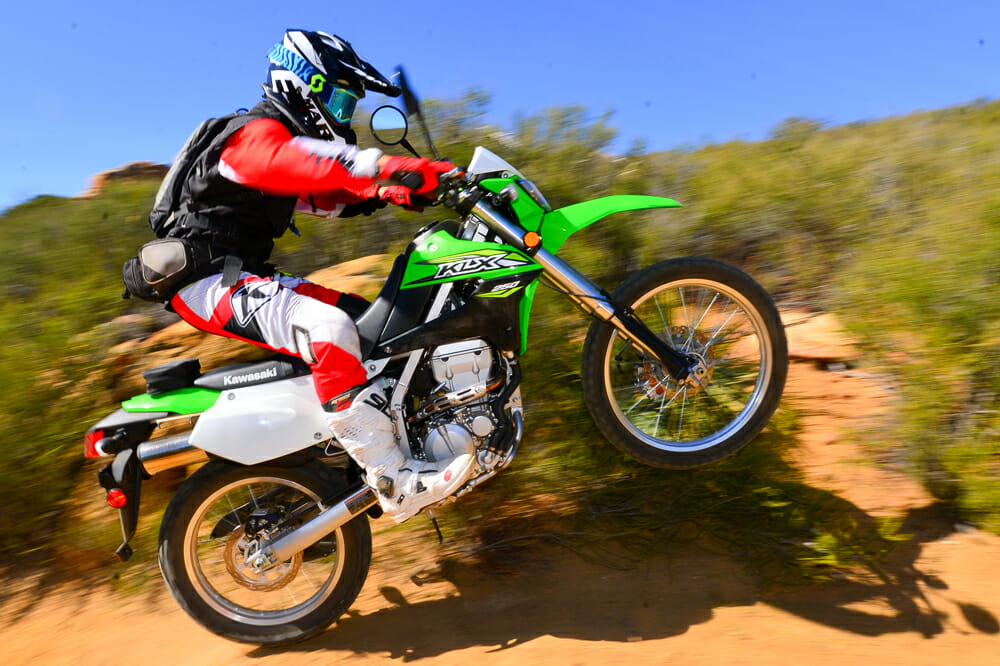
GEAR ID’D
HELMET: Vemar Taku
GEARSET: Klim XC Lite pant/jersey
HYDRATION: Klim Fuel Pak
FANNY PAK: Klim Scramble Pak
BOOTS: Sidi Crossfire 3 SR
GOGGLES: Scott
All three bikes have comfortable ergos, cushy seats and easy-to-use controls (e.g. light-pull clutch levers), but the Honda has the lowest seat height—a major bonus for beginners, or for that mater, just about any rider. This is where the Honda really shines and makes up for its shorter wheel travel. The CRF’s seat height is a good half-inch lower than the KLX’s and a full two inches lower than the WR’s. This is could be a deal-changer for some—mainly beginners and novices—who would just as soon sacrifice some suspension performance for being able to solidly and confidently plant both feet on the ground, or at least one foot without having to lean the bike over too far. The Kawasaki’s is low, as well, but the Yamaha’s is downright high for an entry-level motorcycle at 36.6 inches. But for taller riders, of course, that might not be an issue.
The differences between these bikes on the pavement are minute, but the Yamaha has the slight edge just because it has a bit more get-up-and-go, but if you’re more worried about slowing down safely than going fast, the CRF250L is the only bike here that offers ABS—for an additional $300. (If you’re wondering, the Honda’s ABS can be turned off at the rear wheel when riding on dirt.)
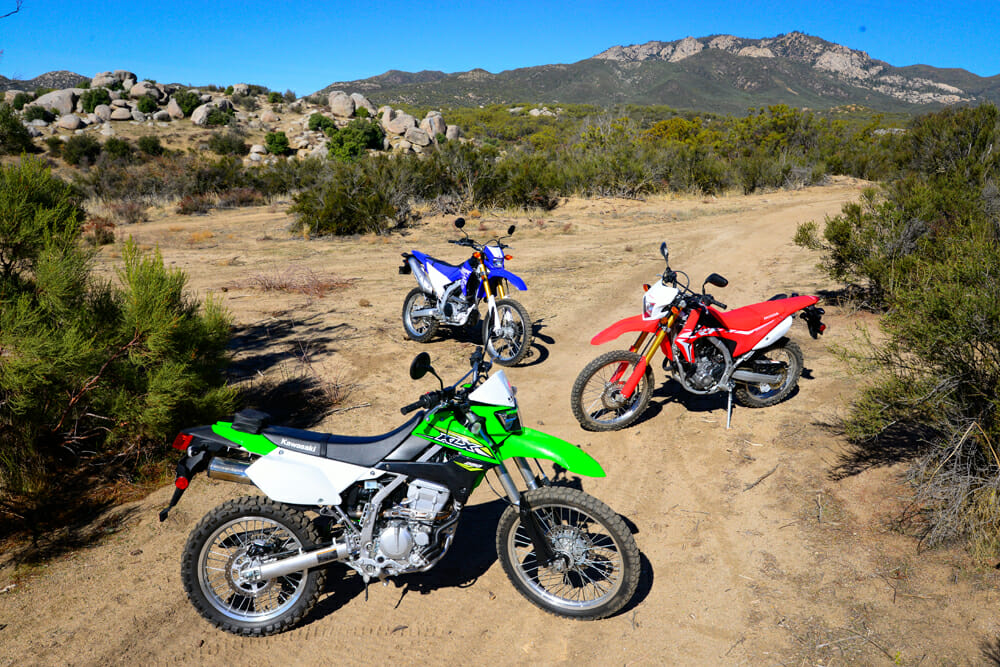
The Honda holds the most fuel, but not by much. Capacity for the Honda is 2.1 gallons and 2.0 gallons for both the Kawasaki and Yamaha. But, hey, every ounce counts, in our opinion. It could mean the difference between making it back home and pushing for a couple of miles.
The Kawasaki is the only bike that drives its odometer with the front wheel; the Yamaha and Honda do so via their transmissions. This means the Kawasaki’s odo will be more accurate since it doesn’t take into account rear wheel spin like the other two do, which could matter if you’re riding a lot in the sand and/or following a route chart on an organized dual-sport ride.
All three bikes have electric starting, which is pretty much a given these days, and all three bikes have six-speed manual transmissions.
The Yamaha is the lightest at 295 pounds, followed by the Kawasaki at 298 and the Honda at 317. Basically, they’re all heavy and you feel it on the trail but not so much on the pavement. Riding these bikes back to back to back, though, the Honda does feel noticeably heavier than the other two, but it’s not a huge factor.
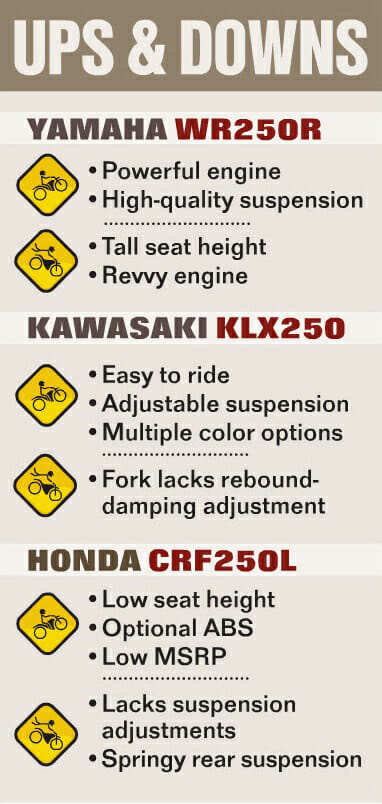
WINNER OR LOSER?
There really isn’t one in this bunch. It just depends which bike fits your needs and skill level best, really. There are a lot of variables. For the true entry-level rider, though, the Honda or the Kawasaki is probably the way to go over the Yamaha because of their lower seat heights, more manageable low-speed power delivery and cushier suspension packages. Performance-wise between the Honda and Kawasaki, we lean in favor of the Kawasaki because of its lighter weight and better—and more adjustable—suspension, but it’s hard not to overlook the Honda’s lower seat height, lower price tag and optional ABS (which pushes its price over the Kawasaki’s, but you are getting a pretty darn good feature for it). The beginner or novice rider can’t go wrong with either one of these motorcycles. Here’s where color or your favorite dealership might be your deciding factor.
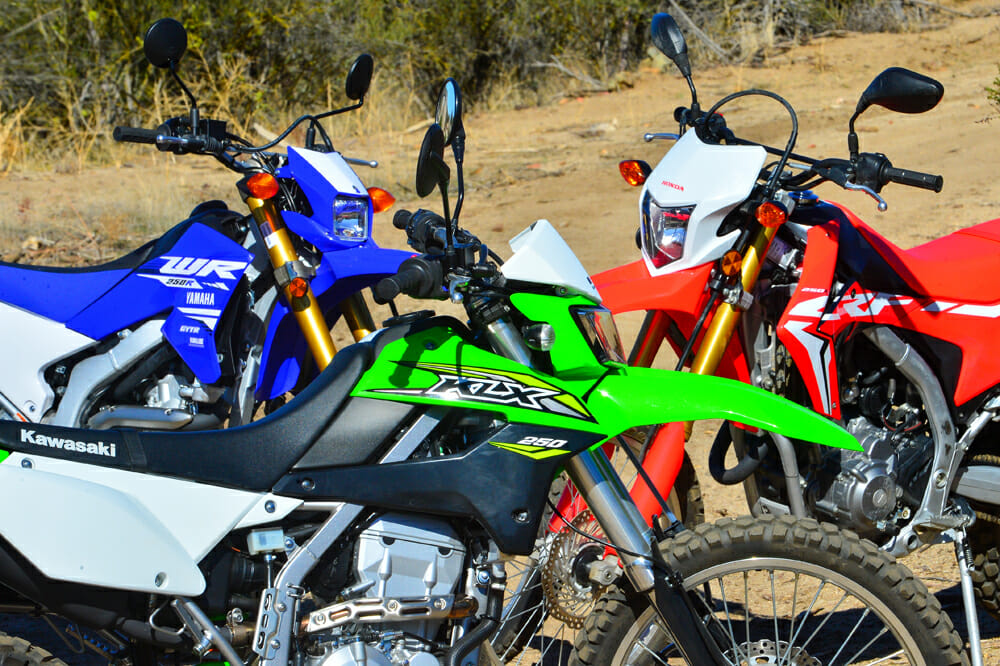
The larger and/or more experienced rider will like the Yamaha best, without question, because it will fit their longer arms and legs better, and they will appreciate the WR’s more capable suspension and more powerful engine over the other two bikes. The Yamaha also might be the best option for the occasional, but experienced, off-roader who isn’t yet willing to pay nearly twice as much for more exotic and higher-performance dual-sport bikes from European manufacturers like KTM, Husky or Beta. Just because the Yamaha is considered an entry-level bike doesn’t mean that the WR doesn’t have the potential to tackle some pretty rough and challenging terrain, because it certainly does, and the fun factor goes up a notch or two as long as you’re not in a big hurry to get where you are going.
Hopefully Suzuki will surprise us with one of its own 250cc entry-level dual-sport bike some day so we can do this comparison all over again. CN

| SPECIFICATIONS |
Kawasaki KXL250
|
Honda CRF250L
|
Yamaha WR250R
|
|
MSRP
|
$5,349
|
$5,149
|
$6,699
|
|
ENGINE
|
Liquid-cooled, DOHC, 4-valve, 4-stroke, single
|
Liquid-cooled, DOHC, 4-valve, 4-stroke, single
|
Liquid-cooled, DOHC, 4-valve, 4-stroke, single
|
|
DISPLACEMENT
|
249cc
|
249.6cc
|
250cc
|
|
BORE X STROKE
|
72.0 x 61.2mm
|
76 x 55mm
|
77.0 x 53.6mm
|
|
COMPRESSION RATIO
|
11.0:1
|
10.7:1
|
11.8:1
|
|
FUEL SYSTEM
|
DFI w/34mm throttle body
|
PGM-FI, 38mm throttle body
|
Fuel injection
|
|
IGNITION
|
Electric CDI
|
Digital w/electronic advance
|
TCI (Transistor Controlled Ignition
|
|
TRANSMISSION
|
6-speed
|
6-speed
|
6-speed
|
|
FINAL DRIVE
|
Chain
|
Chain
|
Chain
|
|
FRAME
|
Tubular, high-tensile steel perimeter
|
Tubular, steel, semi- double cradle
|
Tubular, steel and aluminum, semi- double cradle
|
|
RAKE/TRAIL
|
26.5°/4.1in.
|
27°60’/4.4 in.
|
26.7°/4.4 in.
|
|
FRONT SUSPENSION
|
43mm USD, cartridge, telescopic fork, compression adj.
|
43mm USD telescopic fork
|
46mm USD, cartridge, telescopic fork, fully adj.
|
|
REAR SUSPENSION
|
Single shock, Uni- Trak, fully adj.
|
Single shock, Pro- Link
|
Single shock, fully adj.
|
|
FRONT WHEEL TRAVEL
|
10.0 in.
|
9.8 in.
|
10.6 in.
|
|
REAR WHEEL TRAVEL
|
9.1 in.
|
9.4 in.
|
10.6 in.
|
|
FRONT TIRE
|
3.00-21 in.
|
3.00-21 in.
|
80/100-21 in.
|
|
REAR TIRE
|
4.60-18 in.
|
120/80-18 in.
|
120/80-18 in.
|
|
FRONT BRAKE
|
Single disc 250mm
|
Single disc 256mm (ABS optional)
|
Single disc 250mm
|
|
REAR BRAKE
|
Single disc 240mm
|
Single disc 230mm (ABS optional)
|
Single disc 230mm
|
|
GROUND CLEARANCE
|
11.2 in.
|
N/A
|
11.8 in.
|
|
SEAT HEIGHT
|
35.0 in.
|
34.4 in.
|
36.6 in.
|
|
WHEELBASE
|
56.3 in.
|
56.9 in.
|
55.9 in.
|
|
CURB WEIGHT
(full fuel, claimed)
|
298 lbs.
|
317.5 lbs.
|
295 lbs.
|
|
FUEL CAPACITY
|
2.0 gal.
|
2.1 gal.
|
2.0 gal.
|
|
COLOR
|
Lime Green, Matrix Camo Gray
|
Red
|
Blue
|
|
WARRANTY
|
12 Month Limited
|
12 Month Limited
|
12 Month Limited
|